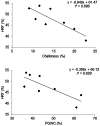Climate change: implications for the yield of edible rice
- PMID: 23776635
- PMCID: PMC3680399
- DOI: 10.1371/journal.pone.0066218
Climate change: implications for the yield of edible rice
Abstract
Global warming affects not only rice yield but also grain quality. A better understanding of the effects of climate factors on rice quality provides information for new breeding strategies to develop varieties of rice adapted to a changing world. Chalkiness is a key trait of physical quality, and along with head rice yield, is used to determine the price of rice in all markets. In the present study, we show that for every ∼1% decrease in chalkiness, an increase of ∼1% in head rice yield follows, illustrating the dual impact of chalk on amount of marketable rice and its value. Previous studies in controlled growing conditions report that chalkiness is associated with high temperature. From 1980-2009 at IRRI, Los Baños, the Philippines, annual minimum and mean temperatures, and diurnal variation changed significantly. The objective of this study was to determine how climate impacts chalkiness in field conditions over four wet and dry seasons. We show that low relative humidity and a high vapour pressure deficit in the dry season associate with low chalk and high head rice yield in spite of higher maximum temperature, but in the opposite conditions of the wet season, chalk is high and head rice yield is low. The data therefore suggest that transpirational cooling is a key factor affecting chalkiness and head rice yield, and global warming per se might not be the major factor that decreases the amount and quality of rice, but other climate factors in combination, that enable the crop to maintain a cool canopy.
Conflict of interest statement
Figures




References
-
- Rosegrant MW, Cline SA (2003) Global Food Security: Challenges and Policies. Science 302: 1917–1919. - PubMed
-
- Zhu DF, Cheng SH, Zhuang YP, Lin XQ, Chen HZ (2010) Analysis of status and constraints of rice production in the world. Scientia Agricultrua Sinica 43: 474–479.
-
- Welch JR, Vincent JR, Auffhammer M, Moya PF, Dobermann A, et al. (2010) Rice yields in tropical/subtropical Asia exhibit large but opposing sensitivities to minimum and maximum temperatures. Proceedings of the National Academy of Sciences of the United States of America 107: 14562–14567. - PMC - PubMed
-
- Nicholls N, Gruza GV, Jouzel J, Karl TR, Ogallo LA, et al.. (1995) Observed Climate Variability and Change. In: Houghton JT, Meira Filho LG, Bruce J, Lee H, Callender BA et al.., editors. Climate Change 1995: The Science of Climate Change: Cambridge Univ. Press, Cambridge, U.K. 133–192.
Publication types
MeSH terms
LinkOut - more resources
Full Text Sources
Other Literature Sources
Medical

